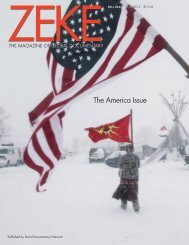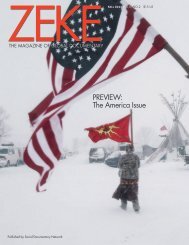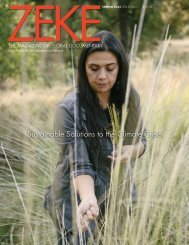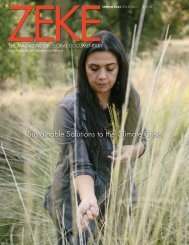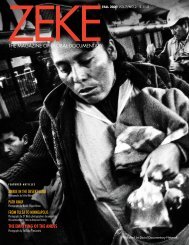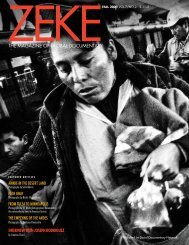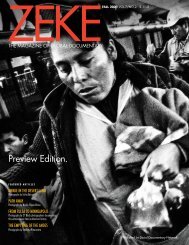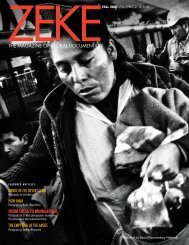ZEKE Magazine: Spring 2023.2
Feature articles on Ecuador by Nicola Ókin Frioli; Ethiopia by Cinzia Canneria, and Ukraine by Svet Jacqueline. Contents: Piatsaw:A Document on the Resistance of the Native Peoples of Ecuadorian Amazon Against Extractivism Photographs by Nicola Ókin Frioli Winner of 2023 ZEKE Award for systemic change Women's Bodies as Battlefield Photographs by Cinzia Canneri Winner of 2023 ZEKE Award for documentary photography Too Young to Fight, Ukraine Photographs by Svet Jacqueline Picturing Atrocity: Ukraine, Photojournalism, and the Question of Evidence by Lauren Walsh Interview with Chester Higgins by Daniela Cohen
Feature articles on Ecuador by Nicola Ókin Frioli; Ethiopia by Cinzia Canneria, and Ukraine by Svet Jacqueline.
Contents:
Piatsaw:A Document on the Resistance of the Native Peoples of Ecuadorian Amazon Against Extractivism
Photographs by Nicola Ókin Frioli
Winner of 2023 ZEKE Award for systemic change
Women's Bodies as Battlefield
Photographs by Cinzia Canneri
Winner of 2023 ZEKE Award for documentary photography
Too Young to Fight, Ukraine
Photographs by Svet Jacqueline
Picturing Atrocity: Ukraine, Photojournalism, and the Question of Evidence
by Lauren Walsh
Interview with Chester Higgins
by Daniela Cohen
You also want an ePaper? Increase the reach of your titles
YUMPU automatically turns print PDFs into web optimized ePapers that Google loves.
Interview
Karnak Temple, Egypt,
2023. Photo by Betsy
Kissam.
CHESTER HIGGINS
Chester Higgins, Jr. has spent over five
decades documenting the African American
experience, past and present. Born in
Fairhope, Alabama, Higgins worked as a
photographer at the New York Times for nearly
forty years. Published collections of his photography
include Black Woman; Feeling the Spirit:
Searching the World for the People of Africa;
Elder Grace: The Nobility of Aging; Echo of the
Spirit: A Photographer’s Journey; and his latest
book, Sacred Nile.
By Daniela Cohen
Daniela Cohen: I’d love to hear
more about how your journey into
photography started?
Chester Higgins: My beginning of photography
was accidental or just fortuitous.
I was a business management major at
Tuskegee and needed a photographer
for display ads in the newspaper. This
photographer had missed a deadline, so
I drove to his house.
Some photographs on his wall struck
me because they were photographs of
poor people, very dignified people.
They reminded me of the dignity of
people from my hometown.
It made me think wow, the image validates
whatever is showing. Most people
of color did not have money to go for a
formal sitting, so I thought, what if I could
give my great aunt and uncle a picture
of themselves to hang on their wall? But
I didn’t know how to make photographs,
so I asked this man to teach me.
A year later, I started making pictures.
I had them framed and took them
down to my great aunt and uncle and
placed them on their wall. My reward
was seeing their faces light up when
they recognized that they themselves
were worthy enough to be on their
walls. Not that they felt any inadequacy
about being themselves, it’s just something
they never thought about.
Essentially, validation is what I’ve
always done with my camera. I started
out with a love for my immediate family.
But it’s been consistently a love
for people who look like me and who
experience the same experience.
I didn’t try to show how badly
Black people are suffering. That sort of
photography sacrificed the humanity
of the people on the altars of racism,
and I refuse to be a party to that sort of
sacrifice. I want my images to be good
food for the mind. It’s very important you
balance out your imagery by using both
the head and the heart. And that’s what
I’ve always done.
DC: It sounds like you’ve been consciously
shifting the narrative that’s
being put out there by the choices that
you’re making.
CH: I cannot do away with the racist
images that everybody has been producing.
What I can do is add another
perspective, so that people will notice
another view as well. So, the spirit
that allowed me to be at the New York
Times for almost 40 years and to apply
change in that paper. I was not the only
photographer there, but I was one who
consistently felt it was my duty to broaden
the view for New York Times readers of
people who look like me. And it being
a paper for decision makers, that was a
very important place to be.
DC: I’m curious about the idea of your
photography giving visual expression to
your personal and collective memories.
Could you talk more about that and how
your photos are connected to themes of
place and identity?
CH: Living is very ethereal—like smoke
from a cigarette. We certainly produce
it, but as smoke, it disappears. So, on
a very personal level, my photographs
are another aspect of keeping a journal.
I keep a journal to unload what has
happened during the day and to have
that as a record that today actually
happened and then as another record of
how I internally process today.
I also tried to get the smoke of the
reality of people in a time before me.
This was a 10-year project looking at
historical photographs made of my
people by other photographers, 99%
White. I spent years going back and
forth to the Library of Congress, going to
see the FSA photographs, going through
the archives of Black colleges or universities
and public libraries. And then
doing more primary research by trying
to locate the family historian in different
communities to see what they had in
their shoeboxes underneath the bed. I
looked for the pictures that I would have
made. That had the same sensitivity that
I would have had, had I been on-site.
I didn’t want to take anybody else’s
pictures though, so I came up with an
idea that I needed a nice, big negative.
I started shooting four by fives with a
light stand that I took with me. I would
have pictures that I fell in love with and
copied. Those copies gradually grew to
many hundreds of contact sheets. And
eventually I was able to do a book called
Some Time Ago: A Historical Portrait of
Black Americans from 1850–1950.
DC: Can you tell me about what first
took you to Africa?
CH: In America, as a Black person, you
are convinced that you’re not American
because you’re not accepted. Your
sense of history comes from people
who despise you, which means that
it can only be warped. As a student
with a minor in sociology, I understood
that if I was going to find out about the
multiplicity of who I and we are as a
people, I had to create my own sources.
And those sources had to be in Africa
because the American academy had
already proven inadequate to that task.
I started spending summers in Africa
hanging out with my ‘cousins’ to learn
from their side. I learned Asante culture
in Ghana, Islamic and Wallof culture in
Senegal, Amharic culture in Ethiopia. I
had a job that took me to Egypt in 1973,
but then the October war broke out,
and I was stuck for another four weeks.
It would turn out to be great for me
because I got a chance to spend more
time at the museum and antiquity sites
and interrogate these things in front of
me that I had had no idea existed, that
no history book told me about. All that
56 / ZEKE SPRING 2023








